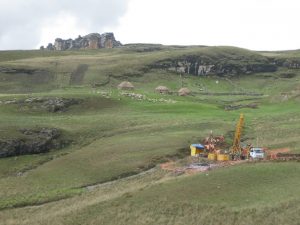![]() Tinka Resources {TSX.V: TK}
Tinka Resources {TSX.V: TK}
Released assay results for four new drill holes at the company’s 100-per-cent-owned Ayawilca property in central Peru.
Hole A19-162 at South Ayawilca intercepted thick zones of zinc mineralisation within the existing resource, but the zinc grades are much higher than expected and are approximately double the average grade of the Ayawilca zinc zone resource.
.
.
.

.
.
.
Tinka Resources drills 19.6 m of 15.2% Zn at Ayawilca
2019-07-29 04:12 ET – News Release
Dr. Graham Carman reports
.
TINKA DRILLS 20 METRES AT 15% ZINC AND 10 METRES AT 17% ZINC AS EXPLORATION CONTINUES AT AYAWILCA FOR ADDITIONAL HIGH GRADE
.
Tinka Resources Ltd. has released assay results for four new drill holes at the company’s 100-per-cent-owned Ayawilca property in central Peru. Three holes were drilled at West Ayawilca and one hole was drilled at South Ayawilca.
.
Hole A19-162 at South Ayawilca intercepted thick zones of zinc mineralisation within the existing resource, as expected; however, the zinc grades are much higher than expected compared with adjacent holes and are approximately double the average grade of the Ayawilca zinc zone resource. Hole A19-162 also intercepted a weakly mineralised limestone layer in the lower portion of the hole, significant in the fact that it supports the company’s thesis of possible limestone-hosted zinc mineralisation lying beneath the existing resource.
.
Key highlights from recent drilling
Hole A19-162 (South Ayawilca):
- 25.4 metres grading 11.6 per cent zinc, 14 grams per tonne silver and 223 g/t indium from 162.6 metres, including 10.0 metres grading 17.2 per cent zinc, 14 g/t silver and 363 g/t indium from 176.0 metres;
- 19.6 metres grading 15.2 per cent zinc, nine g/t silver and 212 g/t indium from 247.4 metres, including 7.2 metres grading 21.8 per cent zinc, 12 g/t silver and 354 g/t indium from 259.8 metres.
Hole A19-159 (West Ayawilca):
- 11.2 metres grading 11.8 per cent zinc and 24 g/t silver from 243.1 m depth (resource infill).
.
Note
True thicknesses of the zinc intersections are estimated to be at least 85 per cent of the downhole thicknesses. Mineralisation in the above intervals are relatively flat-dipping replacement zones hosted by limestone and/or sandstone.
,
Hole A19-162 continued to a depth of 545 metres to test for mineralisation underneath the zinc resource. The deeper portion of A19-162 intersected a layer of limestone containing massive pyrite (with anomalous zinc), a feature often seen near the edge of the zinc zone resource at Ayawilca. A follow-up hole from the same drill platform, A19-163, is in progress.
.
Hole A19-163 intersected several zones of zinc mineralisation in the upper portion of the hole (assays awaited), and mineralisation is believed to remain open updip within an area not previously drilled. The next few drill holes will continue to test the potential extension of South Ayawilca to the west and the limestone at depth.
.
Dr. Graham Carman, Tinka’s president and chief executive officer, stated: “The recently announced preliminary economic assessment (PEA) results for Ayawilca indicated a large zinc project with robust economics, a modest capex and a long mine life. However, the publishing of the PEA should not be construed that the exploration potential of Ayawilca has been exhausted. The company continues to believe that potential remains for the discovery of additional high-grade zinc resources at Ayawilca, and better-than-expected assay results from hole A19-162 reported here, confirm this belief. The addition of high-grade resources, especially at West and South Ayawilca, would clearly enhance the economics of the project as the PEA definitively shows that the project economics is particularly sensitive to zinc grade”.
“The high-grade results in drill hole A19-162 highlight the potential of the South Ayawilca area, in particular, to deliver additional positive exploration results. Mineralization remains open to the west, and at depth, where a deeper limestone layer intersected in hole A19-162 will be tested further by hole A19-163 (in progress). More drill holes are planned, and we look forward to publishing the results in the coming weeks as the assay results come to hand and are interpreted into our geological model.”
.
Discussion
Three holes were drilled at West Ayawilca, of which two holes were stepouts (A19-160 and A19-161) and one hole (A19-159) was an infill hole that also tested for deeper limestone units beneath the existing resource. Holes A19-160 and A19-161 intersected mineralised zinc veins in the upper sandstone layer, but have not extended the limestone-hosted zinc mineralisation at West Ayawilca to the north. The upper portion of hole A19-159 intersected veins in the sandstone above the resource and served as an infill hole, but the deeper portion of the hole did not encounter mineralised limestone at depth (hole drilled to 695 m depth).
.
Hole A19-162 was drilled at the western edge of South Ayawilca, near the hinge of a regional anticline fold. The top approximately 300 m portion of the hole served to infill the existing resource, with assay results (reported here) indicating that this part of the resource has higher zinc grades than expected based on nearby holes. The deeper approximately 250 m portion of this hole was designed to test for repetitions of limestone, the favourable host rock for replacement zinc mineralisation, beneath the phyllite. An approximately 10 m interval of limestone immediately below a major fault was intersected at 465 m depth in hole A19-162. This limestone contains massive pyrite lenses which are commonly found in close proximity to the zinc zone resources at Ayawilca.
.
Hole A19-163 is currently in progress from the same drill pad as A19-162 but angled at a shallower dip. The top of the hole targeted an area close to the edge of the zinc resource and intersected several intervals of zinc mineralisation (assays pending).
.
Hole A19-163 is planned to continue to approximately 480 m depth to test the western limb of the anticline, and has so far intersected strongly altered limestone over an approximately 50-metre interval from 400 m depth (assays pending).
.
The magnetic map shows that magnetic anomalies over the project are strongly correlated with zinc mineralisation, and weaken toward the west and northwest beyond the extent of the mineral resource. The weakening of the magnetic signature to the west is interpreted as a possible plunge of the mineralisation in that direction (yet to be confirmed with drilling). Additional geophysical targets still remain to be tested further with drilling, including the zone 3 area.
.
The company will hold a live webcast — investor hour on Wednesday, July 31, 2019, at 4:05 p.m. Eastern Daylight Time. The president and chief executive officer, Graham Carman, will present the results of the company’s recent PEA and discuss the next steps of the exploration program. The investor hour will be hosted by Gwen Preston of Resource Maven. Following the presentation, there will be a question-and-answer session moderated by Ms. Preston.
.
SUMMARY OF 2019 DRILL HOLES AT AYAWILCA
Hole From To Interval Zn Pb Ag In
(m) (m) (m) (%) (%) (ppm) (ppm)
A19-159 66.70 67.50 0.80* 32.7 0.4 85 92
and 129.20 130.80 1.60* 13.7 0.0 29 14
less
than
and 156.10 158.30 2.20* 7.9 3.2 160 1
less
than
and 170.20 172.80 2.60* 7.9 3.1 122 1
and 243.10 254.30 11.20 11.8 0.03 24 3
and 332.40 333.10 0.70 18.7 0.4 79 1
A19-160 86.80 87.30 0.50* 9.8 0.1 135 6
A19-161 129.90 130.90 1.00* 19.6 3.5 111 1
and 140.00 141.20 1.20* 14.4 0.0 56 0
A19-162 101.90 103.80 1.90 22.8 0.0 31 176
incl. 101.90 102.65 0.75 48.0 0.1 63 375
and 138.40 141.30 2.90 11.3 0.3 19 43
and 162.55 188.00 25.45 11.6 0.1 14 223
incl. 176.00 186.00 10.00 17.2 0.0 14 363
and 247.40 267.00 19.60 15.2 0.0 9 212
incl. 259.80 267.00 7.20 21.8 0.0 12 354
and 279.20 283.30 4.10 15.9 0.3 31 213
Note
Except for veins (marked with an asterisk) which have unknown true
thicknesses, the true thicknesses of the zinc intersections are
estimated to be at least 85 per cent of the downhole thicknesses as
the zinc mineralization at Ayawilca is generally flat-dipping
replacement of layers or mantos hosted by limestone and/or sandstone.
.
.
Notes on sampling and assaying
Drill holes are diamond HQ- or NQ-size core holes with recoveries generally above 80 per cent and often close to 100 per cent. The drill core is marked up, logged and photographed on site. The cores are cut in half at the company’s core storage facility, with half cores stored as a future reference. Half core is bagged on average over one to two m composite intervals and sent to ALS laboratories in Lima for assay in batches. Standards and blanks are inserted into each batch prior to departure from Tinka’s core storage facilities. At the laboratory samples are dried, crushed to 100 per cent passing two millimetres, then 500 grams pulverized for multielement analysis by ICP (inductively coupled plasma) using multiacid digestion. Samples assaying over 1 per cent zinc, lead or copper and over 100 g/t silver are reassayed using precise ore-grade AAS (atomic absorption spectroscopy) techniques.
,
Qualified person
Dr. Carman reviewed, verified and compiled the technical contents of this release. Dr. Carman is a fellow of the Australasian Institute of Mining and Metallurgy, and is a qualified person as defined by National Instrument 43-101.
.
About Tinka Resources Ltd.
Tinka is an exploration and development company with its flagship property being the 100-per-cent-owned Ayawilca carbonate replacement deposit (CRD) in the zinc-lead-silver belt of central Peru, 200 kilometres northeast of Lima. The Ayawilca zinc zone contains 11.7 Mt of indicated resources grading 6.9 per cent zinc, 0.2 per cent lead, 15 g/t silver and 84 g/t indium, and 45.0 Mt inferred resources grading 5.6 per cent zinc, 0.2 per cent lead, 17 g/t silver and 67 g/t indium. The Ayawilca tin zone contains an inferred mineral resource of 14.5 Mt at 0.63 per cent tin, 0.23 per cent copper and 12 g/t silver (this release). A maiden PEA is under way, with results anticipated in the first half of 2019.
.
We seek Safe Harbor.
.
.
.












